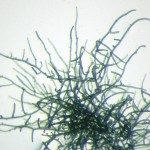Link to Pubmed [PMID] – 31490972
PLoS ONE 2019;14(9):e0222029
Efficient RNA extraction methods are needed to study transcript regulation. Such methods must lyse the cell without degrading the genetic material. For cyanobacteria this can be particularly challenging because of the presence of the cyanobacteria cell envelope. The great breath of cyanobacterial shape and size (unicellular, colonial, or filamentous multicellular) created a variety of cell lysis methods. However, there is still a lack of reliable techniques for nucleic acid extraction for several types of cyanobacteria. Here we designed and tested 15 extraction methods using physical, thermic or chemical stress on the filamentous cyanobacteria Planktothrix agardhii. Techniques based on the use of beads, sonication, and heat shock appeared to be too soft to break the Planktothrix agardhii cell envelope, whereas techniques based on the use of detergents degraded the cell envelope but also the RNA. Two protocols allowed to successfully obtain good-quality RNA. The first protocol consisted to manually crush the frozen cell pellet with a pestle and the second was based on the use of high-intensity ultra-sonication. When comparing these two, the high-intensity ultra-sonication protocol was less laborious, faster and allowed to extract 3.5 times more RNA compared to the liquid nitrogen pestle protocol. The high-intensity ultra-sonication protocol was then tested on five Planktothrix strains, this protocol allowed to obtain >8.5 μg of RNA for approximatively 3.5 × 108 cells. The extracted RNA were characterized by 260/280 and 260/230 ratio > to 2, indicating that the samples were devoid of contaminant, and RNA Quality Number > to 7, meaning that the integrity of RNA was preserved with this extraction method. In conclusion, the method we developed based on high-intensity ultra-sonication proved its efficacy in the extraction of Planktothrix RNA and could be helpful for other types of samples.


